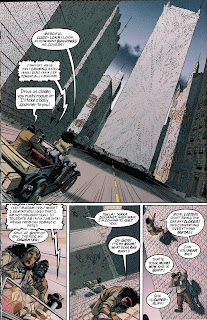 |
| This cover is pretty ugly. Those gradients make everything kinda grey. Art by Chris Sprouse and Angus McKie |
Take the Modular Man. Formerly a scientist named Temple Baldry, the Modular Man has broken his consciousness down into units of information stored in a self replicating machine. As the machine builds more new machines Baldry's personality appears and takes control of them, creating a large wave of smaller robots representing one entity It's interesting to see Alan Moore tapping into the kind of high concept science fiction one might associate with the comics Ellis was writing in this era. On paper The Modular Man sounds like the kind of villain you'd see in the pages of Planetary but when he shows up in Tom Strong the conflict is resolved with a suggestion that you might expect to come out of the mouth of a Mort Weisinger era Superman. Strong, tired of fighting suggests that The Modular Man take over an uninhabited planet, in this case Venus.
The idealistic science fiction of silver age DC superheroes is one of the notable flavors to be folded into these stories. Its particularly refreshing to see Tom Strong employing alternate methods for saving the day like the one mentioned earlier. The vast majority of superhero stories climax with two guys punching each other. I do enjoy my fair share of comic book violence but western superhero action is frequently stiff and honestly, kind of tired outside of the hands of a select few artists. In addition, the authoritarian nature of superheroes generally makes that violence a bit more uncomfortable for me.
 |
| Another splash panel. This one shows off another silver age DC trope employed in this series, the talking Gorilla! Art by Chris Sprouse, Al Gordon, Tad Ehrlich, and Todd Klein |
Chris Sprouse and Al Gordon depict the big concepts as being, well, big. This issue features a succession of large splash panels on most of it's even numbered pages (the left hand page of each two page spread). Those pages usually pull the pov back to reveal the scale of action and objects throughout the story. It's a fun effect, especially when we get to see the cloud of machines that make up the Modular Man's physical form. I'd be remiss if I didn't mention Todd Klein's contributions to the depiction of this character as he handles the lettering. The layered text of the Modular Man's word balloons suggests the effect of his voice being broadcast from multiple units within that cloud.
 |
| Art by Chris Sprouse, Al Gordon, Tad Ehrlich, and Todd Klein |
In general Klein brings more to this series than most letterers get a chance to contribute. I love that he uses a unique typeface for the Ozu's dialect and Solomon the Gorilla's accent. On top of that he gets to develop all sorts of unique styles of type for the many different cover homages throughout the series.
The second issue of this series is much stronger than the first. While that issue worked so hard to give us history and establish the setting of the series, this issue gives us a glimpse of the relationship between the main characters. Moore gives them unique voices and that makes efficient use of the lower word count his comics employed at this time. There's an ease to the delivery of these stories that makes up a large part of their appeal.
Tom Strong #2 (July 1999) was written by Alan Moore with art by Chris Sprouse, Al Gordon, and Tad Ehrlich as well as lettering by Todd Klein

No comments:
Post a Comment